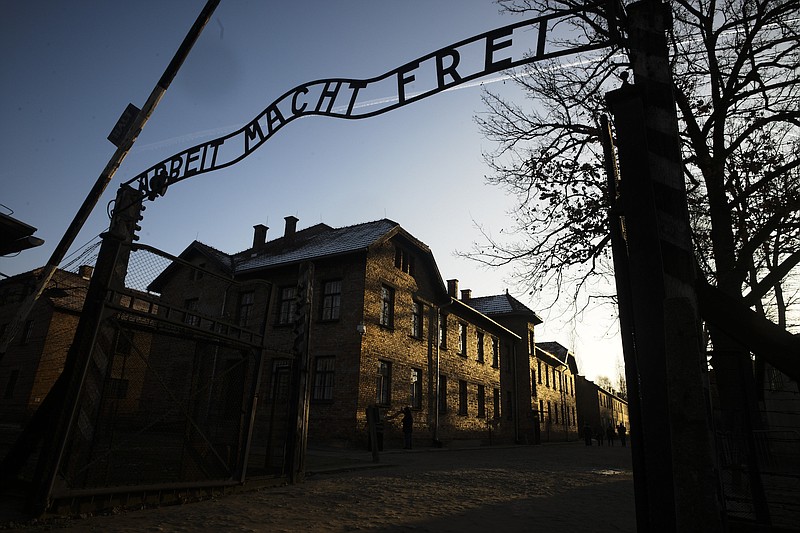Seventy-five years ago, on January 27, 1945, Soviet forces liberated the Auschwitz Concentration Camp, ending one of the most heinous chapters of World War II. In the almost four years of its existence, Hitler's Nazis murdered between 1.1 and 1.4 million people at the site.
About 90% of the victims were Jews from Poland and Western European countries. From mid-May to early July 1944, Nazis transported 440,000 Hungarian Jews to Auschwitz for extermination. Romani people, nonJewish Polish people, and Russian prisoners of war comprised the remainder of the victims.
Heinrich Himmler, who had founded the first Nazi concentration camp at Dachau and oversaw much of the Holocaust, ordered the construction of Auschwitz. Rudolf Höss served as the commandant during the camp's first three years. Tried and convicted for his war crimes, he was executed in 1947.
Auschwitz consisted of a complex of camps built around an extensive rail junction in southern Poland. The first camp, Auschwitz I, erected in the spring of 1940, initially housed Polish political prisoners. It was attached to an armaments workshop. Birkenau (Auschwitz II), a massive death camp, was erected across a bisecting railroad track. A spur from the main rail line entered the camp beneath a stone archway set in the side of a long, brick building. Prisoners proceeded through a second, wrought iron gate, whose arch carried the slogan: Arbeil Macht Frie, "Work Sets You Free." Birkenau consisted of 300 barracks for prisoners, gas chambers and crematoria. A third complex (Auschwitz III), five miles away near the village of Dwary, housed a slave labor force which worked in an adjacent I.G. Farber factory manufacturing synthetic rubber. Once workers at that site became too weak or ill to work in the factory, they were sent to Birkenau.
Forty-four smaller camps fed prisoners into Auschwitz.
(MORE: Survivor stories spotlight Auschwitz liberation anniversary)
Upon arrival by train, prisoners were assessed for their fitness for work. Most women, children and older men failed this examination and were marked for execution in gas chambers. Prisoners selected for work details survived on meager rations and lived in filth. Tuberculosis, gastroenteritis, typhus and streptococcal infections were rampant. Escape was all but impossible.
At the time of the roundup of Hungarian Jews in 1944, two men managed to escape with a detailed map of Auschwitz. Upon transmittal of the map to Western Allies, a debate erupted. Should the rail lines leading to the camp be bombed or even the complex itself to interrupt the mass killings? Allies had known of Hitler's plans to round up and to eradicate European Jews in concentration camps since December 1942. Military and political discussions never resolved the issue of what, if anything, to do with this information. Once again, in 1944, debate resulted in inaction.
As Russian forces advanced into Southern Poland in early January 1945, Nazi officials ordered the evacuation of 60,000 prisoners from the Auschwitz camps. Many died from exposure along the way as they were forced to march in snow or were transported in open-topped cattle cars. The evacuation was completed on Jan. 18.
(MORE: World leaders vow to learn from Holocaust, offer competing lessons)
The 7,600 sick and starving prisoners were left behind with little food, fuel or protective clothing. Their plight is described in the final chapter of "Survival in Auschwitz," a poignant account of life in the camp, written by Primo Levi. An Italian Jew, Levi was arrested in January 1944 and sent to Auschwitz. His background as a chemist led to assignment at the I.G. Farber factory. Shortly before the camp's evacuation, Levi developed scarlet fever and was sent to a cramped infirmary, which housed a dozen men suffering from various infectious diseases. Russian shells fell on the camp, setting fire to several structures.
Pulling together, the patients in the infirmary survived. Scavenging the deserted camp, they found a small stove, some potatoes, a few doses of sulfa drugs and shoes and rags left behind by evacuees. All but one survived.
The Russians brought food and medical care. Help arrived too late for many former prisoners. As soon as their health was stabilized, survivors began lengthy journeys back to their homelands.
Contact Clif Cleaveland at ccleaveland@timesfreepress.com.

